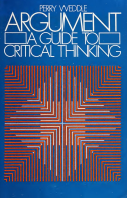 |
Full Title: | Argument A Guide to Critical Thinking |
|---|---|---|
| Author(s): | Perry Weddle | |
| Publishing / Edition: | McGraw-Hill Book Company, 1978 |
 |
Full Title: | Argument A Guide to Critical Thinking |
|---|---|---|
| Author(s): | Perry Weddle | |
| Publishing / Edition: | McGraw-Hill Book Company, 1978 |
Chapter 1 - The Realm of Reason
This chapter covers the meaning of the term "argument" and what constitutes "good reasoning". In this context, "arguments" are not fights. An "argument" is a set of "premises" and a "conclusion". A "conclusion" is a claim about something, whereas a "premise" is a fact which supports it. Arguments can be "simple" (leading to a single conclusion), or "complex" (when the conclusion becomes a premise for another conclusion, a "line of reasoning").Chapter 2 - Fallacy
A "fallacy" is a faulty argument. The author divides them into two general categories of his own naming:Chapter 3 - Language
The author covers not only the structure of arguments, but also how they are worded. He focuses on two main categories, Clarity and Objectivity:Chapter 4 - Authority
The author states that we should "nurture skills for distinguishing reliable authority from poor authority". He provides a few questions that we can ask ourselves to help determine this:Chapter 5 - Generality
"Generalizations" are statements that apply to all or none of something. They "distribute" a property over an entire group. A generalization can be either true or false. They are distinct from statements that summarize results and statements which elaborate on the consequences of a definition.Chapter 6 - Comparison
Whenever we compare two things, we look for similarities and differences between them. "Analogy" is to point out a similarity, while an "analogical argument" is to draw a conclusion from that similarity. While they may not seem as common, the inverse is also possible. A "disanalogy" is to point out a difference, and a conclusion can be drawn from that difference as well.Chapter 7 - Cause
This final chapter covers the concept of "causality" [and issues related to the "scientific method"].Related Resources
• Borrow the eBook from Internet Archive